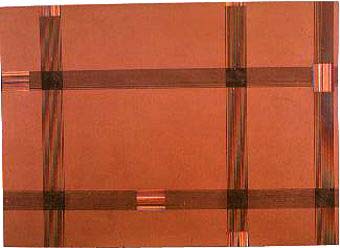


"Regarder et voir venir".
Galerie Nathalie Obadia, Paris.
November 22, 2003 - January 6, 2004
Pascal Pinaud's exhibition 'Regarder et voir venir' at Galerie Nathalia Obadia in Paris finds us amongst works which are by now familiar products from this artist's extensive repertoire. Pinaud's favorite gambit is to present the viewer with objects that are, at least nominally, paintings. These objects are transposed from the ordinary and the everyday; found pieces of crochet assembled on stretchers, panels sprayed with car paint, the aluminum roof of a truck. Pinaud harnesses these ready-mades and assisted ready-mades into the service of questioning abstraction and painting within a context of representation. The humble and diverse origins of fabrication of these objects; light industry, D.I.Y., an artisan's workshop are also important as alternatives to the detached and aloof artist's studio.
However there is a feeling here that non-composition and other distancing strategies are by now almost rituals that artists, such as Pinaud, evoke so that the spectator is in no doubt that all is being conducted with tongue in cheek. The decorative wall and ceiling plaster mouldings which Pinaud festoons across the gallery walls and within and on which the 'tableaux' are hung are a major example of this. This gesture seems to signal the bourgeois context of painting which abstraction historically struggled to distance itself from. However this gesture is often made at the expense of the full singular effect of many of the individual works. This attempt at unifying such diverse works with a single installation begs the question of whether these works actually need such energetic contextual embellishment?
This seems especially so when the most successful works in the exhibition are encountered. Sheep Farm Yellow Nissan is a panel that was left over a period of time in the paint spray work shop of a car body repair garage. Over time it picked up the over spraying from successive paint jobs. The result is virtually a monochrome with a rich, deep, lacquered surface. At the other end of the exhibition is a large canvas, Ecran N°2, leant against a wall on which is printed an image of a painting by Mondrian hung within an exhibition. Close inspection reveals a mark on the painting which extends onto the wall below it. The image is in fact of a Mondrian that an exhibition visitor vomited on. These two works, linked by their preoccupation with 'projection' as decisive processes, throw up an intriguing nexus of readings and associations. The sublimated surface of the sprayed car paint happening on the margin of the common place on the one hand. On the other a utopian work from the canon of purist abstraction, de-sublimated and de-based through the product of a visceral reaction, art folding into life but a long way from the bjectives of Neo-Plasticism.
James Pinson

